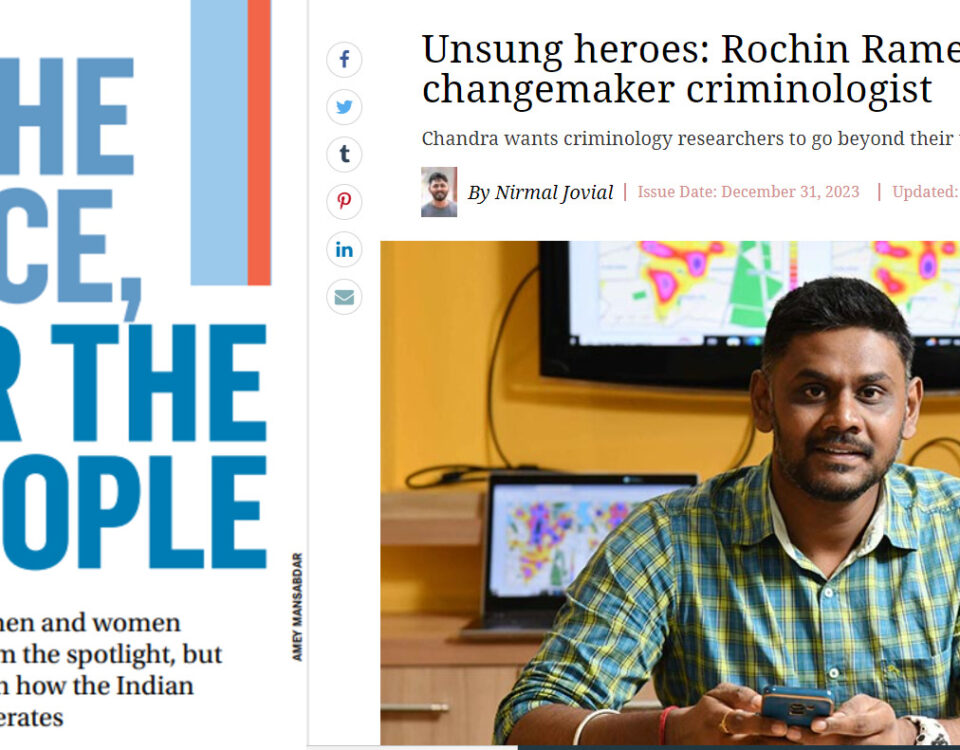Immediate need for integrating criminology with journalism courses, says Shaji

Providing Sexuality Education
November 6, 2019
Social work students urged to seize opportunities in criminal justice
November 19, 2019
KA Shaji. Photo: Special Arrangement
BHASKAR KUMAR INTERVIEWS KA SHAJI | November 12, 2019
In an interview to CCPP, K. A. Shaji, a Kerala-based Indian journalist discussed the relationship between mass media and crime, and the need to connect criminal justice researchers with journalists for better governance, security and justice.
What does the day-to-day life of a crime journalist look like?
Some people call crime reporters either as vultures or as ambulance chasers. While comparing with journalists handling other beats, these people are less privileged. Those reporters who rush to a crime scene or seeking appointment with a grieving family or approaching the police seeking details of a just happened murder would not get a courteous response as generally expected from other sources of news. Society is not giving them the same respect it gives to journalists who handle politics, environment, social issues, art and culture. But reporting crime is integral to the journalism business anywhere and everywhere in the world. It’s the core of the reportage. Readers in spite of their personal aversion to crime journalists prefer to read hear or view chilling crime stories and their curious twists and turns. Without crime stories, no media establishment can survive. It is very important and integral to journalism. People are curious to follow major crimes happening around. Some crime stories and their evolvement invite national and international attentions. Some are turning subjects of intense public debate.
At another level, best crime reporters are chronicling the most extreme aspects of human existence: life, death, trauma, survival. They investigate all aspects for the reportage and the areas of investigation include what happened, why it happened, what the effects are, and whether it could have been prevented. Those are essential questions, not only to victims and their families, but to all of us. The society needs answer to these questions. It’s everybody’s need.
Crime reporting is also a sociological mission. It can give context to the emerging situations. It can explore the real social issues that contributed to the final phase of the crime. It can chase factors which make an entire life difficult, issues that are deeply intertwined with criminal acts: mental health, poverty, racism, addictions and domestic violence. On some occasions, excellent crime reportages help alter laws, or, at least alter broader attitudes and perceptions. They can hold authorities and the justice system up to scrutiny and account. At least, they can simply record what was lost.
While reporting crime, the reporter has to follow many other beats. Larger issues such as child labor, medical fraud, education scams or civic issues among many others get intertwined with crime in one way or another. So the beat serves as a good training ground for trainees and cub journalists. Normally, crime is spontaneous. So the reporter has to be there at the scene of the crime at that moment, just after the news breaks. Being on the spot at the right time is important.
The job of a crime reporter normally involves interviewing the police, victims of the crime, their family and friends and even eye-witnesses. While meeting all such challenges, little sensitivity is essential. They need to ask difficult questions in a tactful manner. The reporter has to deal with both sides. Those people who commit the crime and the others who turn victims of the crime. On most occasions, the victims may turn hostile to the reporter. They will vent out their feelings to the reporter. But the magnitude of a crime can be understood in a deeper sense only by seeing and interacting with the people who turned victims of it.
After gathering of data, the reporter has to cross verify certain details and quotes before releasing the story. People with courage and dedication can come into this field as it involve seeing gruesome sights, meeting injured victims and spending lot of time interviewing the sufferers in hospitals and other spaces with extreme adversity.
What are the essential qualities of a crime reporter ?
Crime reporters and investigative reporters fill a valuable niche in the early 21st century news media. They mine for stories and serve as the public’s watchdogs by uncovering the sordid details of previously hidden corruption and crime, including questionable activities of private businesses, government and criminal syndicates. Their work provides a genuine sense of accomplishment and bolsters the self-worth of those who choose to work as investigative reporters. To succeed, though, these reporters must possess some vital qualities. Motivated by ethics and morals, good investigative reporters must possess a strong sense of right and wrong. Their sound ethics and finely-tuned moral compass guide them in battling to stomp out crime and corruption. Investigative reporters call upon experts to complete sometimes dangerous and exhausting tasks, including meeting secretly with known criminals, scanning financial reports for hours and interviewing dozens of individuals to corroborate a source’s allegations. Good investigative journalists must believe it is their responsibility and civic obligation to uncover facts to ensure fairness, accuracy and transparency.
Successful investigative journalists must be able to follow charts, graphs, accounting logs and legal jargon. Good reporters are capable of managing the material by organizing it, interpreting it and drawing conclusions. Knowledge of the most helpful reporting techniques and tools, including the use of computer-assisted reporting databases and software programs, bolsters reporters’ success in finding and reviewing important data. Good investigative reporters also keep meticulous notes and document all the information.
What are the linkages between crime, journalism and policy-making?
Covering the courts (also police stations) is an important task for the news media for several reasons. First, the judiciary is one of the three branches of government. Therefore, coverage of the courts and police stations fulfills part of the watchdog function of the media. Second, there is a great deal of public interest in what the courts and law and order establishments do, particularly in criminal cases.
Coverage of criminal justice can serve a cathartic purpose for the public in demonstrating that justice is served and criminals are punished. However, coverage of the courts can also expose unfairness in the system, either for victims or defendants that the public may want to lobby its representatives to correct. Coverage may also help prevent injustices by shining a spotlight on the actions of judges, lawyers and other participants in the justice system.
Despite the importance of courthouse coverage, judges and lawyers often complain that news organizations send journalists out to do stories with little training about the complexities of the justice system. Members of the public also complain about sensationalistic reporting that is inaccurate or short on context. Adequate positive interventions are urgently needed in this area to make the reporting more factual and accurate.
Criminology with Journalism has emerged as one of the most sought-after courses in the UK. But that is not the case in India. Can you explain how journalism influences problems of crime and our criminal justice policy?
Journalism must drive justice reform. It has a key balancing role in our criminal justice system. It has a watch dog obligation on police stations, courts and jails. Journalism can ensure justice. It can help protect innocent people from wrong confinements and trials. It can work as an eye-opener before investigating officials and courts. Even in India, what I feel is the immediate need for integrating criminology with journalism courses. Times are changing and autocratic regimes with scant regard for democracy are occupying offices. Only the media can help people voice their resentment against draconian laws with ulterior motives.
Collapse of journalism means collapse of our criminal justice system. From big investigations to individual case studies, the coverage is crucial, and often influential. In places where there are no reporters who are paid to root out these problems, we simply don’t know what kind of corruption, mismanagement, cruelty, and simple mistakes are happening, but we can assume that they are. The relationship between the criminal justice system and the media system has been the subject of research, speculation, and commentary throughout the last hundred years. Put it most simply, neither the media nor the criminal justice system could operate effectively without the other. The criminal justice system is a resource for the media system in that it affords one of the common sources of news and stories. The classical surrogate scout role of the media, whereby they monitor the environment for actual and potential threats to individual and collective welfare, affords a powerful way for the media to attract their audiences. People must constantly update their understanding and ability to orient themselves to the environments in which they act.
For the criminal justice system to operate effectively, it must have the authority that derives from people’s willingness to grant it legitimacy, and media storytelling can profoundly affect this process. Allocation of scarce resources to the criminal justice system also depends upon success in the struggle to get “its” story positively framed and widely disseminated to media audiences. These macro dependency relations serve as context for examinations of specific aspects of media, criminal justice, public, and decision-maker relations.
Media industry offers career opportunities across a wide spectrum of disciplines including criminology and criminal justice. Yet, it has an embarrassingly low number of professionals from such educational backgrounds. Why is that so?
Why are we so fascinated by crime and deviance? If the media can so successfully engage the public’s fascination, can they equally tap into—and increase— people’s fears about crime? Is the media’s interest in—some would say, obsession with—crime harmful? What exactly is the relationship between the mass media and crime? Students and researchers of both criminology and media studies have sought to understand the connections between media and crime for well over a century. It’s interesting to note that, although criminologists and media theorists rarely work together, striking parallels can be found between their efforts to understand and “unpack” the relationships between crime, deviance, and criminal justice on the one hand and media and popular culture on the other. Indeed, it is not just at the interface between crime and media that we find similarities between the two disciplines. Parallels between criminology and media studies are evident even when we consider some of the most fundamental questions that have concerned academics in each field, such as “What makes a criminal?” and “Why do the mass media matter?” The reason for this is that as criminology and media studies have developed as areas of interest, they have been shaped by a number of different theoretical and empirical perspectives that have, in turn, been heavily influenced by developments in related fields, notably sociology and psychology, but also other disciplines across the arts, sciences, and social sciences. Equally, academic research is almost always shaped by external forces and events from the social, political, economic, and cultural worlds. In the case of integrating criminology and with journalism, respective organizations and journalism schools must think of larger collaboration.
What are the prospects of bringing journalists and academic criminologists together for the promotion of evidence-based criminal justice policy?
Evidence-based policy (EBP) is a term often applied in multiple fields of public policy to refer to situations whereby policy decisions are informed by rigorously established objective evidence. Underlying many of the calls for evidence-based policy is often a (stated or unstated) concern with fidelity to scientific good practice, reflecting the belief that social goals are best served when scientific evidence is used rigorously and comprehensively to inform decisions, rather than in a piecemeal, manipulated, or cherry-picked manner. The move towards evidence-based policy has its roots in the larger movement towards evidence-based practice. Journalists and academic criminologists can do a lot in this area.
For example, criminologists can encourage journalists to take advantage of academic research as sources in their reporting, drawing attention to how research findings can create powerful news stories relevant to their audiences. The use of evidence as a basis for journalistic reporting would not only enhance the accuracy and objectivity of their news story, but also help journalists to address issues in a more informed and impactful way. In the same way, criminology researchers can use the media to advance their findings to the top of the policymakers’ agendas and shape public opinion around issues of crime.
How can media play a positive role in the construction of newsworthy items about crime and justice?
In the areas of Crime and Punishment, media can ensure required levels of responsibility. Quality reporting can enhance standard of criminal jurisprudence. It can prevent corruption and favoritism. It can critically engage lawyers, judges and law enforcing officials. Criminal law uses (the warning and imposition of) punishment in an attempt to prevent future crime and maintain social order. So the media can help boost that aspect.





